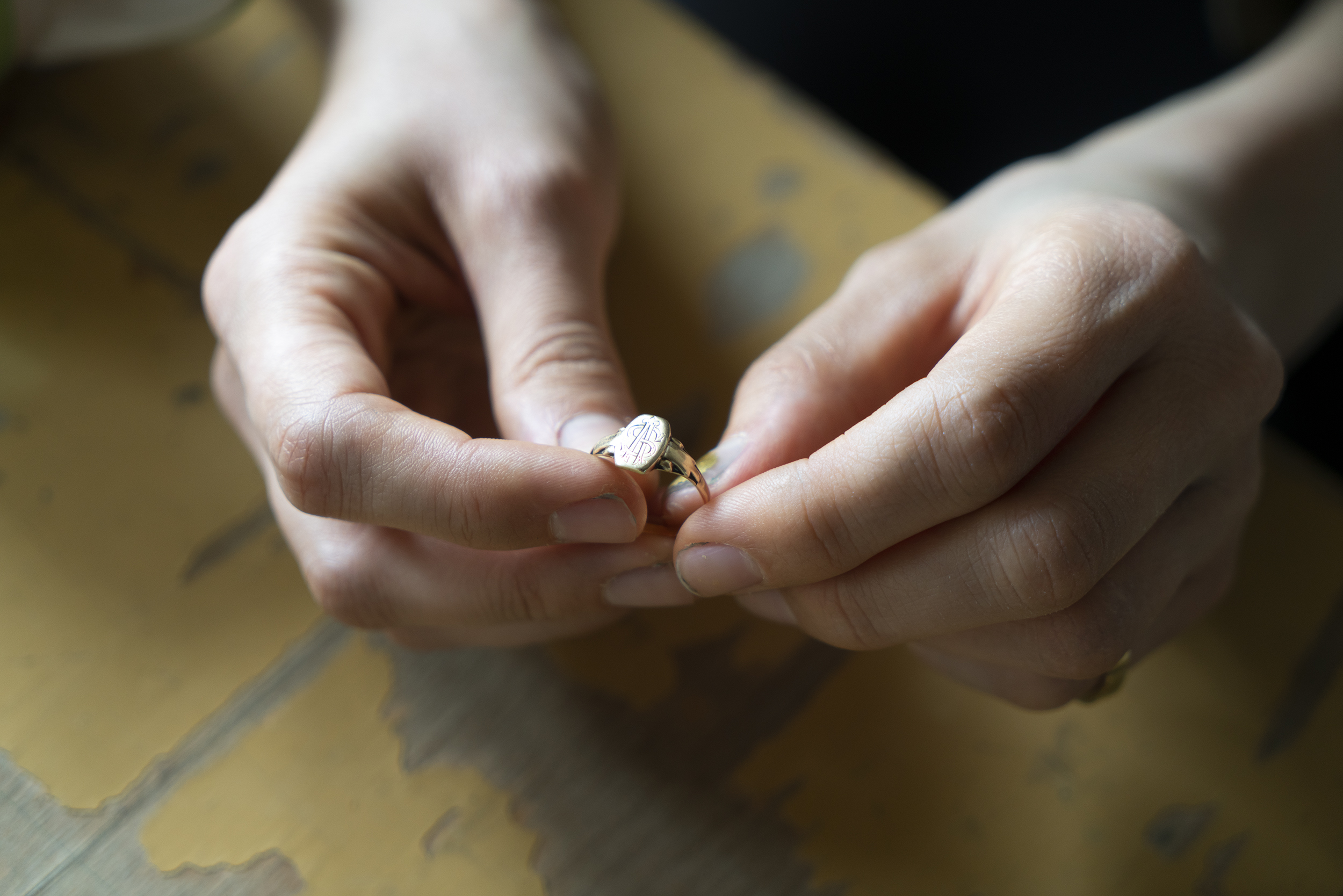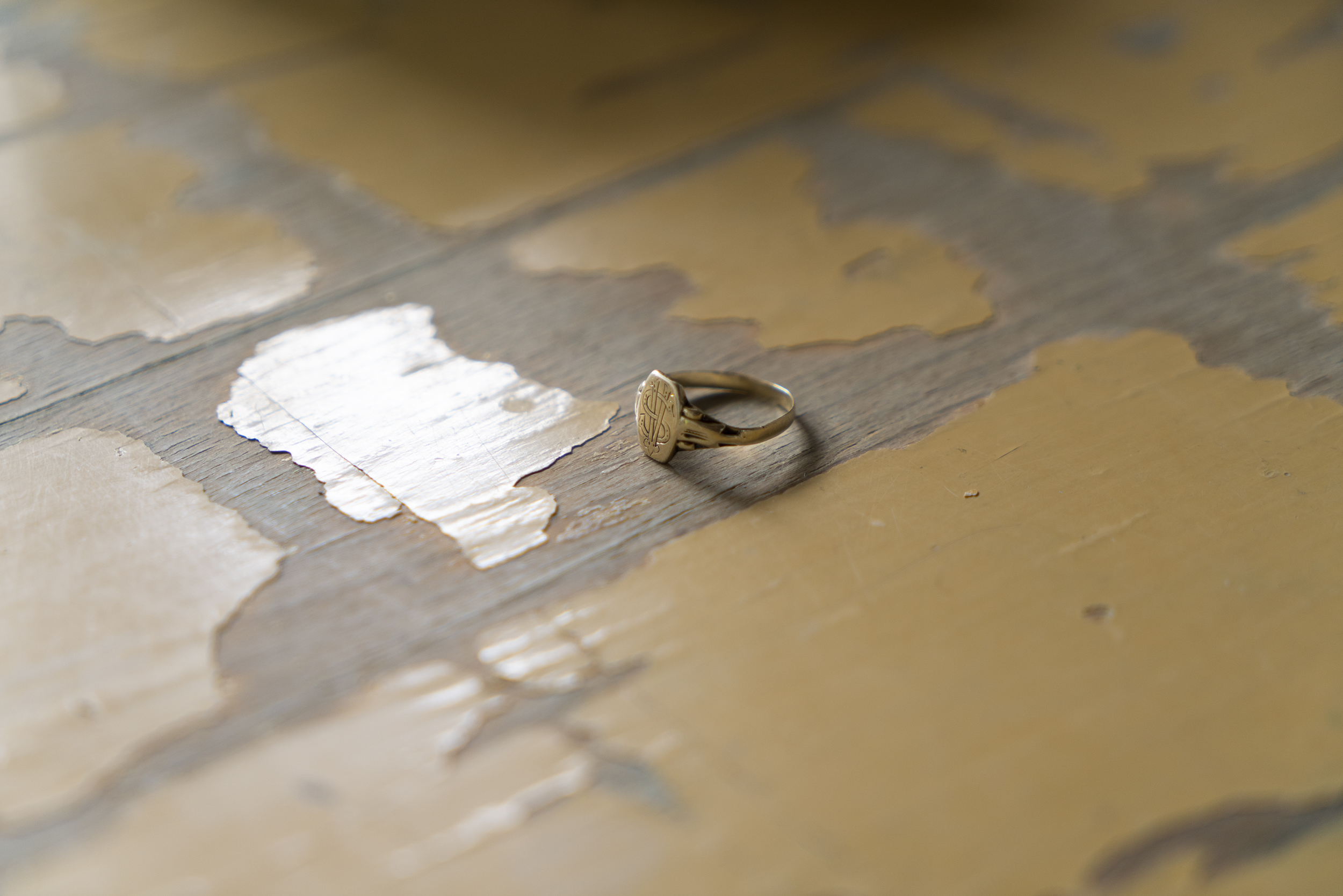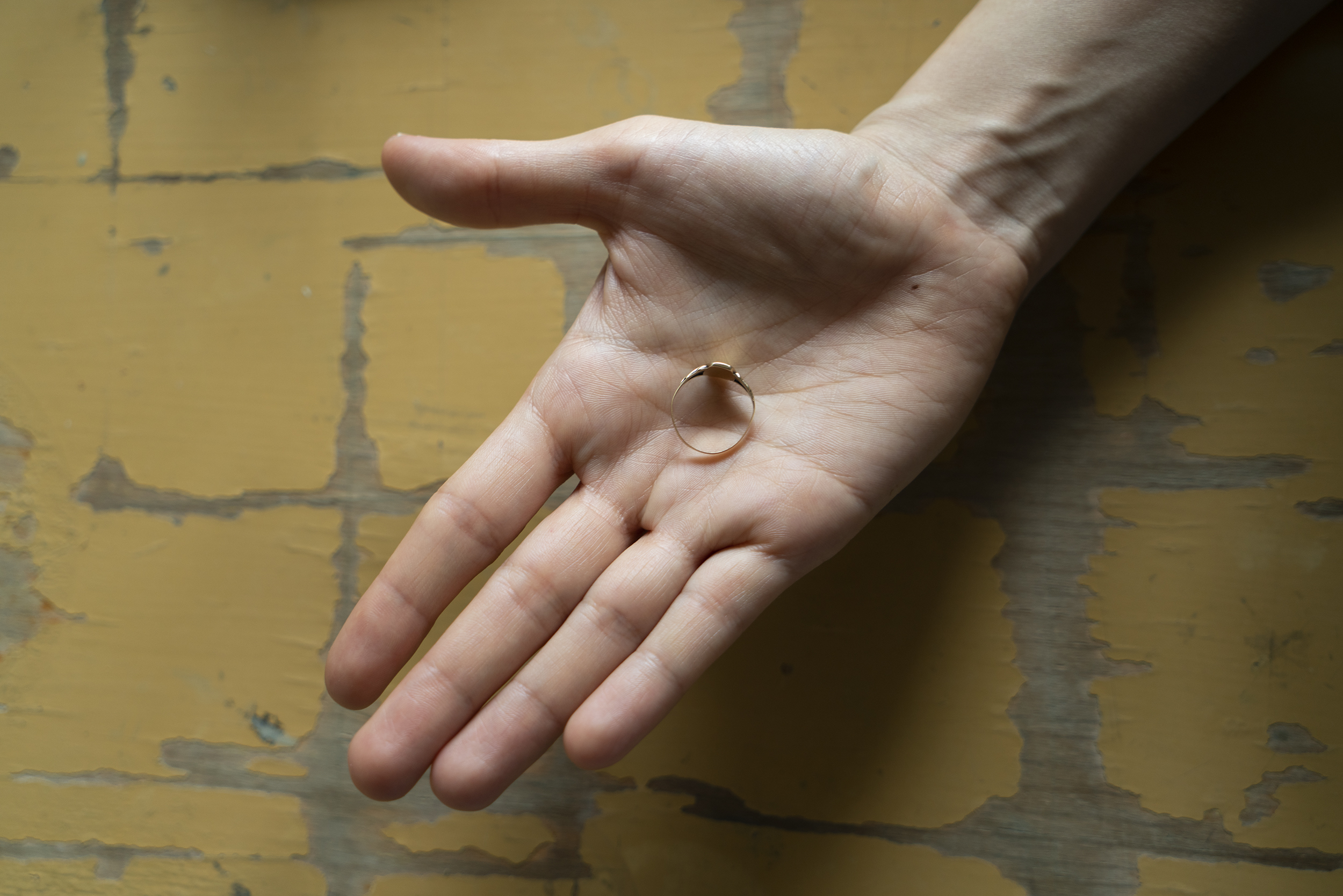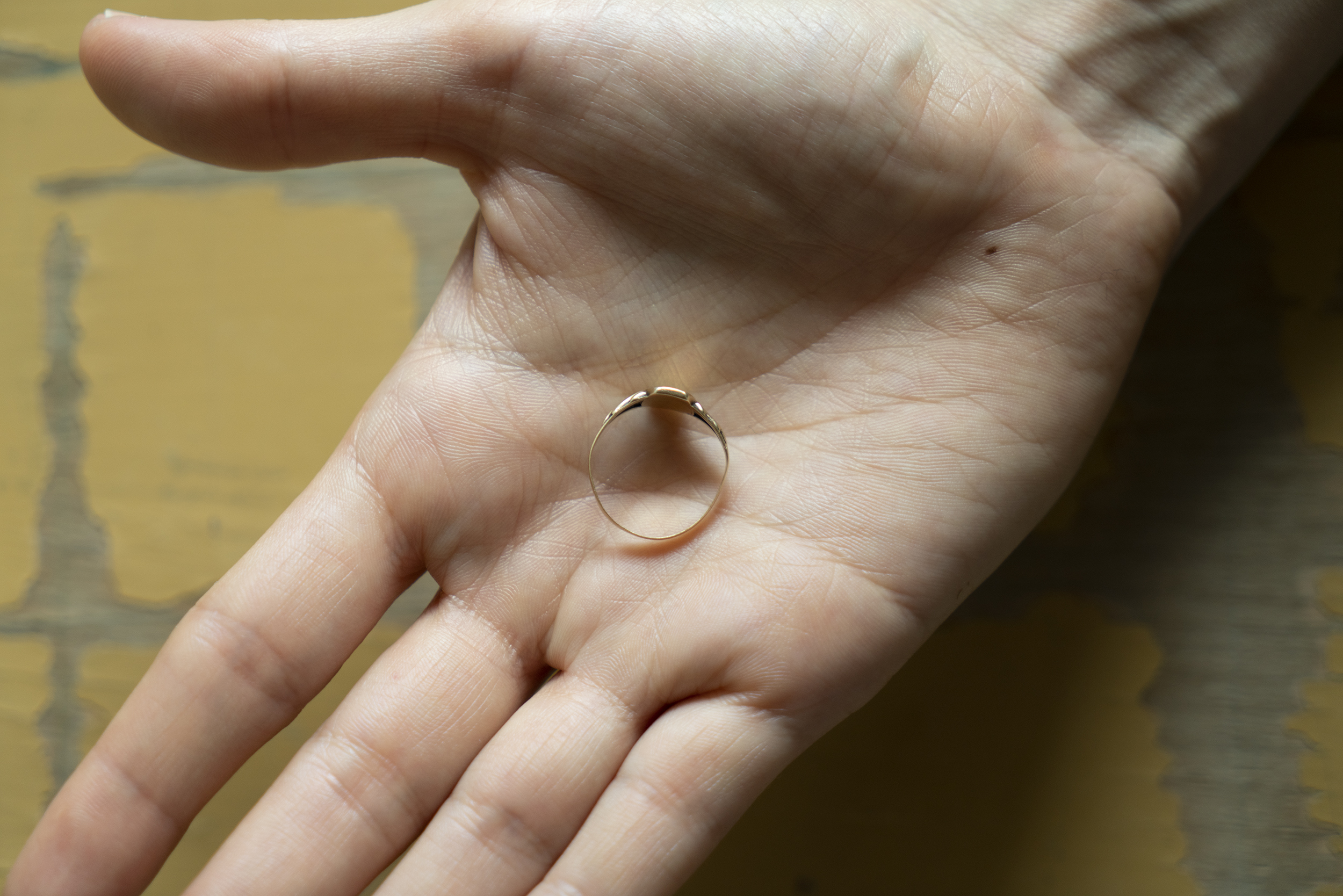Close Things / DANA TOMEČKOVÁ, In Time to Disappear and Grow
On the memory of close things, reincarnations of jewels and the mysterious life of matter with Dana Tomečková

Ring. That’s a really close thing, perhaps nothing could be closer to the body.
And it’s getting even…closer with time? By getting progressively thinner. I feel like it’s like a second skin. I chose this thing for itself, for its mass, its physicality, but also because it’s connected to my grandmother. There’s a continuity, a closeness to it. But this ring also illustrates my thinking, it inspires me. It represents for me a good example of thinking about how matter transforms over time.
I see the initials V.S.
These are the initials of my grandmother, Viera Suchálová, who gave me the ring. She discovered it in a porcelain mug where she keeps her jewellery in her cupboard, and she said: Take this, Danuška. And then when I came home and showed to Vilo (Viliam Slaminka, Dana’s partner) what I had received, he said: It’s me! I liked how it connected.
I really like this ring also because it shows the time. You can see how that structure has disappeared from the sides: here it still remains, here it doesn’t. Even the depth of what is engraved is diminishing, it’s very shallow now.
What still fascinates me about the ring is that, from a certain point of view, it’s already so thin that you can barely see it. I think sometimes about what it must have been like in the beginning when my grandmother got it. How much bulk it had, how much it weighed, it must have been quite a bit more than it is now. I guess that’s why he’s so close to me – you can see him leaving, but he’s still here.
Is it possible that it will thin out with wear to the point where the mass loosens and opens up?
One can say that it is such a tension for several years, or even decades, until the circle opens.
Do you know its story? Who did your grandmother get it from?
It was a gift from my grandfather. I don’t know what the occasion was, but I guess he wanted her to have something “solid.” The ring looks like it’s handmade, there are little imperfections on it, you can see it in the monogram. That’s what I like about it too – you can see that it was made by a hand. It’s rare nowadays. Being a jeweller myself, I know that it’s much easier to have something like this made by machine. There are fewer and fewer people who do engraving. Even for me, it’s something I don’t go into because it requires special training and practice that you get over the years. Those who are doing it today are mostly such elderly gentlemen.

Do you wear it every day?
Yes, I do everything with it…even sleep with it. It’s probably the only ring I wear all the time.
It’s so slightly off-set, it’s not a perfect circle anymore.
That ring also inspires me in what I do in my work. When I think about time and the transformation of material, it’s the best example for me of how matter changes over time. When I think about what it looked like before and what it looks like now, it’s very interesting to imagine where the gold that’s no longer on it might have gone. And how something so durable and stable – which is what we think of as gold – could have disappeared in the first place. But at the same time you know that it couldn’t have disappeared into thin air, that it had to be somewhere.
The idea of the layers of the ring peeling away, so inadvertently and slowly, at the level of the most imperceptible particles of material, is strange. It is hard to imagine such a “coming away” of material.
Gold is always worked with something harder than itself. So when it comes into contact with, say, a metal handle, or something that is made of steel, it makes some unnoticeable indentation on it. But if we wring it in our hands for twenty years, it doesn’t get lost.
That is, it disappears in contact with other things… with life.
Yes, with things, with people… The ring changes in life and in movement, in contact with something else. If it were in a showcase somewhere, it wouldn’t change. But this way you can see it’s alive. It has a tension in it, stemming from the anticipation of when it will actually open.
And what will it mean when it opens?
For example, when I shrink a ring, I cut it open, and then there is a moment when the saw itself jumps when the ring opens – there is tension in it. It’s a moment where I hold my breath because I have to slow down, I know it’s going to happen. The metal has its strength because the particles of the material are very close together. When you hit it and open it up, or it’s too thin and it loosens on its own, you can feel the movement – it’s as if the thing breathes out.
This is a beautiful moment. This ring, too, seems to be waiting for its exhale.
Yes, but it’s not a final exhale. Gold is a very magical material in that you can turn it into something else. It’s a noble material because it’s never lost, it doesn’t depreciate in the process. Gold can always become something else – and another – and another. It’s different from brass or copper, for example. Metals that are not noble are devalued when they are smelted – that is, when they go through high heat. That’s why you always have to replace them or add a pure material. Gold is truly “eternal” in this sense, its transformation can go on and on and it does not degrade. Also this ring was definitely something else before.

Sounds like some “reincarnation” of jewelry. Have you ever thought about that?
I think about it a lot when I’m making jewelry for someone and working with things they bring me from the “family chest”. And that’s what’s interesting about it, because with the composition and the carats and the ratios, I notice, for example, that a certain formula was probably used during the war, when gold was being saved. There are different admixtures that are put into gold, and you can tell by that what period it probably was, and you can also tell by the hallmark. So when someone brings me gold from a “family hoard”, I think of giving that material a new form, and that form of jewelry was also different before.
As if you, as a human being, a jeweller, were forming a link in a sequence of different transformations. And now a question comes to mind, which is a bit metaphysical…do you think that all these “reincarnations” will somehow be remembered in that material?
To me, yes, it’s like such a karma thing. Some people are sensitive to that, they wouldn’t buy something from a pawn shop. I believe that an object carries a story – and therefore when you wear it, you carry its story. Maybe you can “cleanse” it by refashioning it, but I really believe that the material has a memory. I think we need to have that awareness, respect, or some sensitivity to what we wear. You can be a continuator in a story, but at the same time you are embedding that object in your story, in your life. And that’s the new, big space that opens up for that thing. It enters into a new context, and thanks to you it also enters into other, new situations that you shape. It’s not just that the thing and its story shapes you, but the other way around.
The situation when my grandmother gave me the ring was very natural. It wasn’t ceremonial at all, in the sense of, oh, here’s your grandfather’s ring, and there’s a fanfare in the back. We were in the kitchen, I think we had just finished baking gingerbread cookies, and she just automatically pulled it out and gave it to me, and I put it on my finger. It was completely natural. It sat right away and I felt comfortable with it. That’s how it landed in my life.
That’s nice, it was a special moment, but without any ceremony.
Yes. It had a certain lightness to it, but it was also commonplace.
And do you know how your grandmother came up with the idea of giving you a ring at this moment?
I think she was just handing the sugar off the shelf and opened the cupboard where she kept it in this little porcelain cup. So here’s the deal: you go to pass the sugar and you pass the ring.
